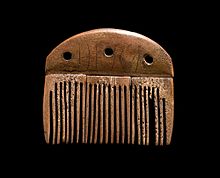
The Vimose Comb is housed at the National Museum of Denmark.
Finds from Vimose, on the island of Funen, Denmark, include some of the oldest datable Elder Futhark runic inscriptions in early Proto-Norse or late Proto-Germanic from the 2nd to 3rd century in the Scandinavian Iron Age and were written in the time of the Roman Empire.
- Vimose Comb (c. 160, considered the oldest known datable runic inscription altogether): harja (ᚺᚨᚱᛃᚨ)[1]
- Vimose Buckle (c. 200) aadagasu =? ansuz-a(n)dag-a(n)su / laasauwija =? la-a[n]sau-wija;[2]
- Vimose Chape (c. 250): mariha || [.]ala / makija; possibly "Mari (the famous one) is the sword of Alla"[3]
- Vimose Woodplane (c. 300) talijo gisai oj: wiliz [..]la o[...] / tkbis: hleuno: an[.]: regu[4]
- Vimose Sheathplate (c. 300): awgns; possibly "son/descendant of Awa"[5]
- Vimose Spearhead: [w]agni[ŋ]o[6]
See also
- Illerup
- Meldorf fibula
- Thorsberg moor
References
- ^ "Deutungen zu einer Inschrift". www.runenprojekt.uni-kiel.de.
- ^ "Deutungen zu einer Inschrift". www.runenprojekt.uni-kiel.de.
- ^ "Deutungen zu einer Inschrift". www.runenprojekt.uni-kiel.de.
- ^ "Deutungen zu einer Inschrift". www.runenprojekt.uni-kiel.de.
- ^ "Deutungen zu einer Inschrift". www.runenprojekt.uni-kiel.de.
- ^ "Deutungen zu einer Inschrift". www.runenprojekt.uni-kiel.de.
- Seebold, Elmar (1994). "Die sprachliche Deutung und Einordnung der archaischen Runeninschriften". In Düwel, Klaus; Neumann, Hannelore; et al. (eds.). Runische Schriftkultur in Kontinental-Skandinavischer und -Angelsächsischer Wechselbeziehung. Walter de Gruyter. pp. 56–94. ISBN 3-11-014328-3.
External links